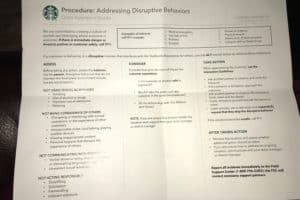Starbucks Anti-Bias Training “Missed the Mark Completely,” Say Two Philly Baristas
Fabiola Cineas, Philadelphia Magazine, May 30, 2018
{snip}
I spoke with the baristas separately on Tuesday evening after they attended the training at a Sheraton hotel with employees from about four districts in the region. Between 1 p.m. and 7 p.m., they had sat with fellow employees listening to a few presentations, watching a number of videos, journaling, and occasionally talking to colleagues and session leaders in small self-guided groups. (Starbucks has made all materials from the training session available here.)
Both baristas told me that the training had missed the mark completely. Instead of addressing racial tension head on, the training mostly “beat around the bush,” said one of the baristas, a 24-year-old Latino man we’ll call Jamie. “I was really disappointed when I walked out of there because I was expecting so much more,” said the other barista, an 18-year-old black woman we will call Tina.
Here’s more on what they said went wrong:
The Training Hardly Addressed the Incident Itself
At the training, attendees were split up into small groups and given iPads to watch videos, a 68-page guide with information, and a journal titled “My Notebook,” where they responded to prompts by writing answers and filling in bubbles.
{snip}
According to Jamie, the Starbucks representatives leading the session got close to talking about the arrest of the two black men only when attendees brought it up.
The Focus on Police Brutality Was Upsetting
“The videos of cops knocking people down and fighting people were really disturbing,” Tina explained. “I told them I didn’t like the video and they told me they understood and that I was open to give my opinion.” What does watching videos about police brutality have to do with the situation that happened, Tina said she kept asking herself. {snip}
“At one point,” said Jamie, “a girl at my table actually had to get up and leave because video after video they showed black people being assaulted by police or black people being verbally assaulted and white people being racially biased toward people of color. {snip}”
The Training Felt More Like an African-American History Class
“We got too deep into black history and got past what I thought was the point of the session,” Tina said, pointing out that one of the videos they watched went back to lunch-counter sit-ins of the 1960s.
For Jamie, a lot of the training was overly focused on how black and Latino people feel about being black and Latino. “If your racial training is supposed to be inclusive, why aren’t you also talking about what white people face, since they’re part of the problem too.” Jamie said. {snip}
The Presenting Leadership Team Was Not Diverse
According to Jamie, the training leaders were three white women and one white man; a woman of color spoke briefly at the beginning of the session but then left. “If you’re having people of color dig into their racial identity, why have non–people of color address us to start things off?” he said. “Not that the white women weren’t credible. But if you’re trying to be sensitive toward us, why would you do that?”
Pandering With Common
As Starbucks previously announced, the training videos featured the rapper Common, but it was unclear to the baristas why he was included. “It made it seem like they were pandering to us as a people, which is rude,” said Jamie. “What does Common know about anything that we’re going through? What does he have to do with anything?”
Starbucks’s New Terminology Was Difficult to Swallow
During the session, attendees were introduced to the phrase “color brave.” According to the training material, the first step to becoming “color brave” is addressing one’s biases and how to override them. {snip}
{snip} “Every activity focused on people of color and how they feel about their race.” Tina left all of the following questions in her journal blank, calling the exercise “just ridiculous”:
{snip}
It’s Unclear What Comes Next
“Racism has been here before Starbucks, and racism will continue to be here after Starbucks,” said Jamie. “It’s weird they focused so heavily on how we feel about our racial identity, because how is that going to help me deal with a homeless person using drugs in my bathroom?”
{snip}
Tina doesn’t expect anything to change this week or next, but hopes to see changes in the next few months. {snip} The rules outlined on Tuesday are below:
{snip}
















